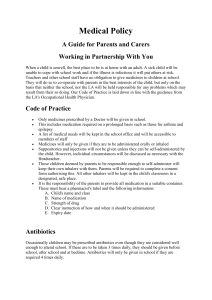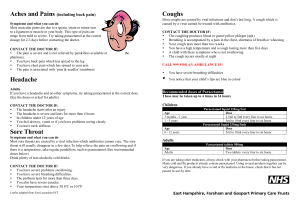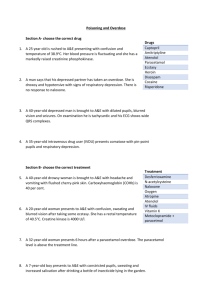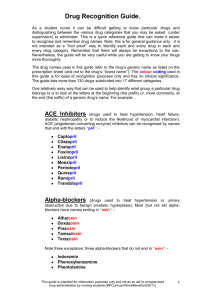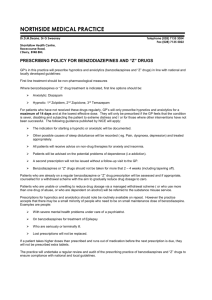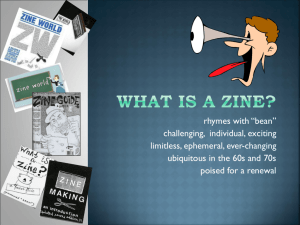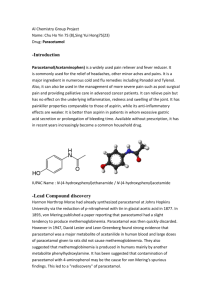Drug Recognition Guide for Student Nurses
advertisement
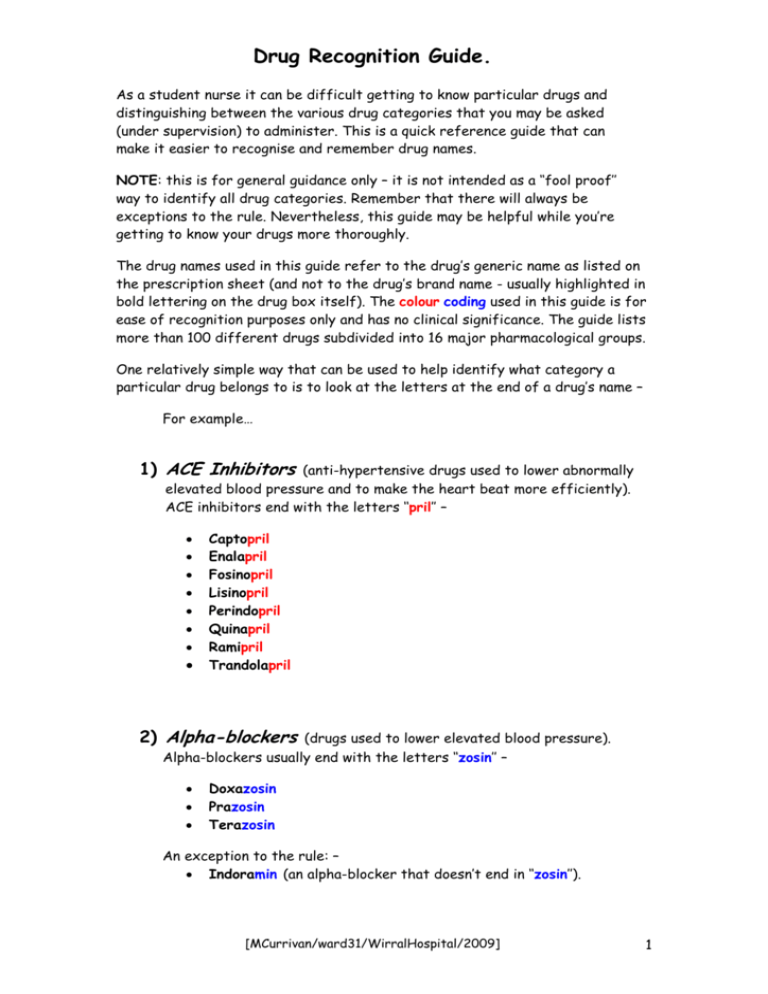
Drug Recognition Guide. As a student nurse it can be difficult getting to know particular drugs and distinguishing between the various drug categories that you may be asked (under supervision) to administer. This is a quick reference guide that can make it easier to recognise and remember drug names. NOTE: this is for general guidance only – it is not intended as a ‘‘fool proof’’ way to identify all drug categories. Remember that there will always be exceptions to the rule. Nevertheless, this guide may be helpful while you’re getting to know your drugs more thoroughly. The drug names used in this guide refer to the drug’s generic name as listed on the prescription sheet (and not to the drug’s brand name - usually highlighted in bold lettering on the drug box itself). The colour coding used in this guide is for ease of recognition purposes only and has no clinical significance. The guide lists more than 100 different drugs subdivided into 16 major pharmacological groups. One relatively simple way that can be used to help identify what category a particular drug belongs to is to look at the letters at the end of a drug’s name – For example… 1) ACE Inhibitors (anti-hypertensive drugs used to lower abnormally elevated blood pressure and to make the heart beat more efficiently). ACE inhibitors end with the letters ‘‘pril’’ – • • • • • • • • Captopril Enalapril Fosinopril Lisinopril Perindopril Quinapril Ramipril Trandolapril 2) Alpha-blockers (drugs used to lower elevated blood pressure). Alpha-blockers usually end with the letters ‘‘zosin’’ – • • • Doxazosin Prazosin Terazosin An exception to the rule: – • Indoramin (an alpha-blocker that doesn’t end in ‘‘zosin’’). [MCurrivan/ward31/WirralHospital/2009] 1 Drug Recognition Guide. 3) Angiotensin receptor blockers (ARBs) (drugs used to lower blood pressure) end with the letters ‘‘sartan’’ – • • • • • Candesartan Irbesartan Losartan Telmisartan Valsartan 4) Class II calcium antagonists (drugs used to lower blood pressure and to treat angina) end with ‘‘ipine’’ – • • • • • • Amlodipine Felodipine Isradipine Lacidipine Nicardipine Nifedipine Note a number of drugs with superficially similar endings: Carbamazepine (an anti-convulsant drug used to treat epilepsy) and Olanzapine (an anti-psychotic used to treat schizophrenia). 5) Beta-blockers (drugs used to lower blood pressure and to treat conditions such as angina and anxiety) usually end with ‘‘lol’’ or ‘‘olol’’ – • • • • • Atenolol Bisoprolol Metoprolol Propranolol Sotalol Not to be mistaken for drugs that end in ‘‘mol’’. Many drugs that end with ‘‘mol’’ contain Paracetamol as a constituent part. 6) Paracetamol (painkillers that also have an anti-pyretic effect). The prefix ‘‘co-’’ at the beginning of some drug names is an indication that they are a combination of two different drugs. For example: • • • Co-codamol Co-dydramol Domperamol = = = (Codeine & Paracetamol). (Dihydrocodeine & Paracetamol). (Domperidone & Paracetamol). An exception to the rule: • Salbutamol (a bronchodilator used to relieve breathlessness which, despite ending in ‘‘mol’’, does not contain Paracetamol). [MCurrivan/ward31/WirralHospital/2009] 2 Drug Recognition Guide. 7) Non-steroidal anti-inflammatory drugs or NSAIDs (anti-inflammatory painkillers that work by reducing prostaglandin levels) often (but not always) either end with or contain the letters ‘‘fen’’ – • • • • • • Aceclofenac Diclofenac Fenoprofen Flurbiprofen Ibuprofen Ketoprofen An important exception to the rule: • Tamoxifen (a hormone-based drug used in the treatment of breast cancer) ends in ‘‘fen’’ but isn’t an NSAID). Two drug groups both of which have an anti-emetic (anti-sickness) effect and both of which end in ‘‘zine’’ are - 8) Phenothiazines (anti-psychotic drugs developed in the 1950s to treat schizophrenia but which are now also used to treat nausea and vomiting) often end with the suffix ‘‘zine’’ – • • • Levomepromazine Prochlorperazine Trifluoperazine (brand name ‘‘Stelazine’’). 9) Anti-histamines (drugs used to treat allergic reactions that can also be used as anti-emetics) commonly end in ‘‘zine’’ – • • • Cinnarizine Cyclizine Promethazine Note two important ‘‘zine’’ ending drugs that are not anti-emetics – • • Hydralazine (a vasodilator used to lower blood pressure). Mesalazine (a salicylate anti-inflammatory drug used in the treatment of ulcerative colitis and Crohn’s disease). 10) 5HT3 antagonits (drugs used to treat severe nausea and vomiting) end in ‘‘setron’’ – • • • Granisetron Ondansetron Tropisetron [MCurrivan/ward31/WirralHospital/2009] 3 Drug Recognition Guide. 11) H2 blockers (drugs used to treat oesophageal reflux, dyspepsia and gastric ulcers) end with the suffix ‘‘idine’’ – • • • • Cimetidine Famotidine Nizatidine Ranitidine Exceptions to the rule: – Clonidine and Moxonidine (both atypical anti-hypertensive drugs) and Chlorhexidine (an anti-septic solution). 12) Proton pump inhibitors or PPIs (drugs used in the treatment of or prevention of gastric ulcers) end in ‘‘prazole’’ – • • • • Lansoprazole Omeprazole Pantoprazole Rabeprazole Not to be confused with the similar sounding antibiotics Co-trimoxazole and Metronidazole. 13) Antibiotics (drugs used to treat bacterial infections). Many antibiotics tend to end with ‘‘cillin’’ or ‘‘cin’’ – • • • • Amoxycillin Ampicillin Flucloxacillin Penicillin • • • • • • • Amikacin Azithromycin Clarithromycin Erythromycin Gentamicin Levofloxacin Vancomycin Not to be confused with Acemetacin or Indomethacin (atypical NSAID drugs used to treat rheumatoid arthritis). Antibiotics that are exceptions to the rule (and that don’t end in ‘‘cin’’ or ‘‘cillin’’) include Ceftazidime, Ceftriaxone, Cephalexin, Co-trimoxazole, Metronidazole, Imipenem, Meropenem and Trimethoprim. [MCurrivan/ward31/WirralHospital/2009] 4 Drug Recognition Guide. 14) Benzodiazepines. (Benzodiazepines are drugs that have both anxiolytic and hypnotic effects. Anxiolytics are drugs given to reduce anxiety. Hypnotics are sedatives sometimes given to treat insomnia). Most benzodiazepines end with ‘‘zepam’’ – • • • • • • • • Clonazepam Diazepam Flurazepam Lorazepam Lormetazepam Nitrazepam Oxazepam Temazepam Note two important benzodiazepines that don’t end with ‘‘zepam’’ – • Chlordiazepoxide (brand name: ‘‘Librium’’. A benzodiazepine often used to treat the symptoms of alcohol withdrawal). • Midazolam (a benzodiazepine sedative often added to syringe driver infusions for patients facing terminal illness). 15) Bisphosphonates (drugs used to treat osteoporosis and to lower elevated serum calcium levels. The drug inhibits bone re-absorption and so both preserves bone density and prevents the release of excess calcium into the bloodstream). Bisphosphonates end with ‘‘dronate’’ – • • • • • • Alendronate Clodronate Etidronate Pamidronate Risidronate Zolendronate 16) Hypolipidaemic agents or Statins (drugs given lower elevated serum cholesterol levels). Most statins end with ‘‘vastatin’’ – • • • • • Atorvastatin Fluvastatin Pravastatin Rosuvastatin Simvastatin An exception to the rule: – • Nystatin (an anti-fungal agent used to treat candidiasis). [MCurrivan/ward31/WirralHospital/2009] 5 Drug Recognition Guide. Summary ACE inhibitors Alpha-blockers Antibiotics ARBs Benzodiazepines Beta-blockers Bisphosphonates Calcium antagonists H2 blockers NSAIDs Paracetamols PPIs Statins 5HT3 antagonits end with… end with… end with… end with… end with… end with… end with… end with… end with… end with… end with… end with… end with… end with… pril zosin cin or cillin sartan zepam olol dronate ipine idine fen mol prazole vastatin setron [MCurrivan/ward31/WirralHospital/2009] 6
